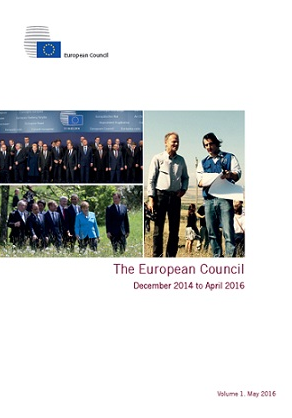Larch, Martin ,Malzubris, Janis, Santacroce,Stefano,(2016),”Fiscal Consolidation in Ireland: Recent Successes and Remaining Challenges”, Directorate-General for Economic and Financial Affairs/ European Economy Economic Brief 011, May Ireland very successfully shouldered an impressive amount of fiscal consolidation under its 2011-2013 EU-IMF financial assistance programme. After peaking at around 12% of GDP in 2009 (excluding deficit-increasing financial sector measures), the general government deficit is expected to have fallen below 2% of GDP in 2015. As …Read More
The European Council: December 2014 to April 2016
European Council, (2016), “The European Council: December 2014 to April 2016”, European Council, Volume 1. May 2016 The European Council faced critical political challenges from December 2014 to April 2016. These included unprecedented flows of asylum seekers and irregular migrants, the need to prevent the exit of Greece from the eurozone and the imperative to find a new settlement for Britain ahead of an In/Out referendum on EU membership. European leaders …Read More
Fiscal Reaction Functions for European Union Countries
Berti, Katia, Colesnic, Eugeniu, Desponts, Cyril, Pamies, Stephanie, Sail, Etienne, (2016), “Fiscal Reaction Functions for European Union Countries”, European Commission, Discussion Paper 28, Αpril This paper estimates country-specific fiscal reaction functions (FRFs) for selected European countries and tests for a change in fiscal behaviour since the beginning of the economic and financial crisis. The estimated country-specific FRFs, as well as a panel FRF for Central and Eastern European countries, are used in medium-term projections …Read More
The Economic Impact of Selected Structural Reform Measures in Italy, France, Spain and Portugal
European Commission, (2016), “The Economic Impact of Selected Structural Reform Measures in Italy, France, Spain and Portugal”, Institutional Paper 023, April This paper presents a rigorous methodology for analysing the potential impact of structural reforms by looking at actual measures in four Member States (Italy, France, Spain and Portugal). The model simulations show that the selected reform measures examined could have significant economic benefits in terms of GDP and employment. …Read More
Quarterly Report on the Euro Area
European Commission, (2016), “Quarterly Report on the Euro Area”, Volume 15, No 1, Institutional Paper 024, April Structural reform measures underway in Italy, France, Spain and Portugal could have significant economic benefits and raise GDP, model simulations presented in this edition of the QREA show. Other chapters in this edition look at the effects of population ageing and slowing total factor productivity growth on GDP, inflation and interest rates; and the drivers …Read More
Taxing Wages 2016
OECD, (2016), “Taxing Wages 2016”, OECD Publishing, Paris, April This annual flagship publication provides details of taxes paid on wages in OECD countries. It covers: personal income taxes and employee contributions paid by employees, social security contributions and payroll taxes paid by employers, and cash benefits received by in-work families. It illustrates how these taxes and benefits are calculated in each member country and examines how they have an impact …Read More
Investment in Europe: making the best of the Juncker Plan
Rubio, Eulalia, Rinaldi, David , Pellerin-Carlin, Thomas,(2016), “Investment in Europe: making the best of the Juncker Plan”, Jacques Delors Institute Studies&Reports, March This report, written by Eulalia Rubio, David Rinaldi and Thomas Pellerin-Carlin, respectively senior research fellow ans research fellows at the Jacques Delors Institute and foreworded by Enrico Letta, vice-president of the Jacques Delors Institute, analyses the strengths and weaknesses of the Juncker Plan. Based on the Plan’s preliminary results, experts’ opinions, …Read More
Economic Bulletin
European Central Bank, (2016), “Economic Bulletin”, Issue 2/2016, 24 March At its monetary policy meeting on 10 March 2016, based on the regular economic and monetary analyses, the Governing Council conducted a thorough review of the monetary policy stance, in which it also took into account the new macroeconomic projections by ECB staff extending into the year 2018. As a result, the Governing Council decided on a set of measures …Read More
Annual Report 2015
European Central Bank, (2016), “Annual Report 2015”, 7 April 2015 was a year of recovery for the euro area economy. Inflation, however, remained on a downward path. Against this backdrop, a key theme for the euro area in 2015 was strengthening confidence. Confidence among consumers to boost spending. Confidence among firms to resume hiring and investing. And confidence among banks to increase lending. This was essential to nurture the recovery …Read More
Savings and investment behaviour in the euro area
Rodriguez Palenzuela, Diego, Dees, Stéphane, (2016), “Savings and investment behaviour in the euro area”, European Central Bank, Occasional Paper Series No 167, January Although monetary union created the conditions for improving economic and financial integration in the euro area, in the context of the financial and sovereign crises, it has also been accompanied by the emergence of severe imbalances in savings and investment, credit and housing booms in some countries and the allocation …Read More












